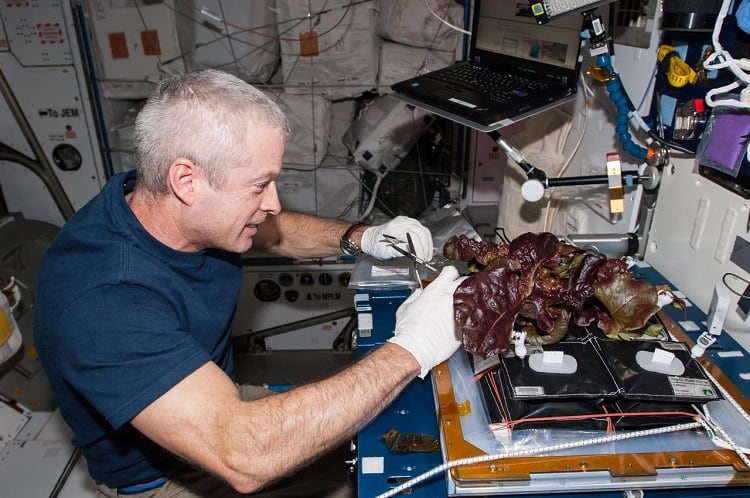Between 2014-2016, red romaine lettuce was grown on the International Space Station (ISS).
Scientists ‘planted’ surface-sterilised seeds in a plant-growth chamber nicknamed ‘Veggie’ – equipped with LED lighting and a watering system. The lettuce was cultivated for 33 to 56 days.
Once harvested, crew members ate some of the leaves, and froze the rest for chemical and biological analysis back on earth.
Now, the results are in. And Gioia Massa, Life Sciences Project Scientist at the NASA Kennedy Space Center, told FoodNavigator the findings hold much promise for future long-distance space missions.
Vertical farming in space?
‘Veggie’ is a closed system, meaning that temperature, carbon dioxide and humidity data can be monitored.
This method, Gioia explained, is not dissimilar to vertical farming. Otherwise known as plant factories, vertical farms are vertically-stacked, fully controlled environments used to produce food.
“Our growth techniques have many similarities to terrestrial vertical farming,” Gioia told FoodNavigator. “We work closely with the controlled environment agriculture community as we are developing future space crop production hardware.”
NASA’s current Veggie system – built by Orbital Technologies Corporation – is not as sustainable as its future systems will become, the life sciences project scientist predicted, “but we are learning lessons from Veggie to figure out what aspects of plant growth needs to be monitored and controlled in future space crop production systems”.
Currently, the team is using a substrate with controlled release fertilizer mixed into it. However, in the future, Gioia suggested any substrate will have to be reusable – “or preferably, we will not have a substrate”.

Zero gravity lettuce ‘safe to eat’
In order to compare the space-grown lettuce with its conventional counterpart, scientists grew control plants on Earth under the same conditions. Temperature, carbon dioxide, and humidity data were logged on the ISS, and replicated in the Kennedy Space Center with a 24-48 hour delay.
When the deep-frozen lettuce was analysed back on Earth, scientists found that it was largely similar in composition to the Earth-grown controls.
However, in some – but not all – trials, space-grown plant tissue tended to be richer in certain elements, such as potassium, sodium, phosphorous, sulphur, and zinc. Phenolics, which are molecules with ‘proven antiviral, anticancer, and anti-inflammatory activity’ were also detected.
A biological analysis revealed that the 15 most abundant microbial genera on the leaves, and 20 on the roots, were similar for both Earth-grown and space-grown plants. None of those detected are known to cause disease in humans.
“This study indicated that leafy vegetable crops can produce safe, edible, fresh food to supplement to the astronauts’ diet, and provide baseline data for continual operation of the Veggie plant grown units on ISS,” noted the study authors.
A potential diet change for Mars
According to Gioia, fresh produce – such as space-grown lettuce – could help improve astronauts’ diets on longer missions.
Currently, astronauts have a ‘great processed and packaged food system’, he explained, comprising of around 180 foods and ‘another couple of dozen’ beverages and condiments.
However, while the food system is nutritious and of high quality, over time both the vitamins and quality degrade. “This is not a concern on the ISS, where they receive fresh food regularly, but it is a concern for a Mars mission [planned for the late 2020s], where the food may have to be sent in advance of the crew.”
The upcoming Artemis-III missions, scheduled to land humans on the lunar south pole by 2025, is also classified ‘long distance’.
“Thus we are looking at growing fresh produce to supplement this packaged diet to provide the nutrition that the astronauts will need.”
Fresh produce can also help to provide new textures and flavours for the crew, Gioia continued, and may help with ‘menu fatigue’ by adding variety to the diet. “Growing plants may provide psychological benefits to the crew as well,” he added.
The scientist also suggested that growing plants can impact life support needs – which could prove crucial to further space exploration.
“Plants take up the carbon dioxide the astronauts are breathing out and they generate oxygen for the crew to breathe. If we ever want to be self-sustainable in space colonisation, plants will be integral.”

Lettuce today, sweet potatoes tomorrow?
The team has used these same growing techniques for other leafy green crops, with success.
Now, they are working to develop approaches suitable to growing small fruits, such as tomatoes and sweet peppers, and initiating ground research on herbs.
“Right now, there is no way to cook anything on the ISS, so fresh salad crops and herbs that can be consumed without processing are highest priority,” Gioia told this publication. “Microgreens are another area of active research, as these may be very applicable to spaceflight.”
When the crews have cooking capabilities, such as a microwave or oven, the team will look at vegetables that require ‘minimal processing’, such as potatoes or sweet potatoes.
“For longer term systems on a planetary surface, additional staple crops might be grown to help provide the diet, but things like wheat and soybean will require significant processing before consumption, so those are pretty far down the road.
“This type of production would be suitable when we have a near permanent base on the surface of the Moon or Mars, for instance.”
Source: Frontiers in Plant Science
‘Microbiological and Nutritional Analysis of Lettuce Crops Grown on the International Space Station’
Published 6 March 2020
DOI: https://doi.org/10.3389/fpls.2020.00199
Authors: Christina L. M. Khodadad, Mary E. Hummerick, LaShelle E. Spencer, Anirudha R. Dixit, Jeffrey T. Richards, Matthew W. Romeyn, Trent M. Smith, Raymond M. Wheeler and Gioia D. Massa.




